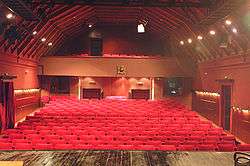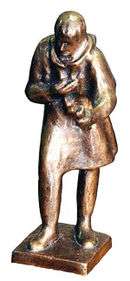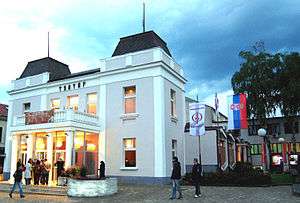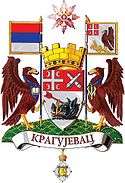Knjaževsko-srpski teatar
| Joakim Vujić Theatre | |
 | |
| Address |
Daničićeva 3 City of Kragujevac Serbia |
|---|---|
| Opened | February 15, 1835 |
| Website | |
| www.joakimvujic.com | |
Knjaževsko-srpski teatar (Serbian Cyrillic: Књажевско-српски театар) is the oldest theatre in Central Serbia. It is based in City of Kragujevac, the fourth largest city of Serbia. The theatre was founded in 1835 by Miloš Obrenović, Prince of Serbia. In the time when theatre was founded, Kragujevac was first capital of the Principality of Serbia.[1]
History


Joakim Vujić (1772–1847), writer, translator, foreign languages teacher, most esteemed universal theater creator, Director of Knjazesko Srbski Teatar, First Serbian Court Theater Director in Kragujevac 1835/36.
Report on the performance of the first secular play Krestalica in the Theater Rondella in August 1813 in Budapest that translated and organized Joakim Vujic. This performance marked the beginning of the Serbian secular theater.
August von Kotzebue (1761–1819) one of the most fruitful German writers seemed to be Vujic favorite playwright for he translated seven Kotzebue's plays.
It is renewed after World War II, and turned to be most open cultural institution of the City that spread its influences around. The stage of this theater gave rise to the plead of extremely good artists who marked the history of theater in the country.
Theater in City of Kragujevac that bears the name of the father of first Serbian theater Joakim Vujic has developed its repertoire and staged performances and turned into modern contemporary theater.
First theater performances are staged in 1825 by the teacher Djordje Evgenijevic and his pupils. During his second visit to Kragujevac Joakim Vujic worked together with them.
In the autumn of 1834 at the invitation of Grand Duke Milos, Joakim Vujic, best known and highly esteemed person for his theater work, came to Kragujevac with large experience and repertoire. He was very soon appointed Director of the Theater with the task to organize theater work.
Knjazesko Srbski Teatar – First Serbian Court Theater was placed within the adapted premises of typography and it was a building with the stage, boxes and ground floor. The repertoire of the theater consisted mainly of his plays while the theater ensemble beside Vujic as a leading actor and director consisted of secondary school pupils and adult amateurs.
First performances were staged in the period of February 2–4, 1935 when the so-called Sretenje (the Visitation of the Virgin) Assembly sessions were held. These were mostly Vujic's plays performed for the Grand Duke and his family and the representatives of the people i.e. members of Assembly; the music was composed by Jozef Slezinger.[2]
Repertoire
Season 2009/2010 – the selection: Story about the late emperor daughter by Nikolai Koljada and directed by Boško Dimitrijević, Pinocchio by Carlo Collodi, director and scene designer Dušan Bajin, The liar and the archiliar by Jovan Sterija Popović, director and scene designer Dragan Jakovljević, Le ultime lune by Furio Bordon and directed by Massimo Luconi, Maids by Jean Genet and directed by Ivona Šijaković, The diari of a madman by Nikolai Gogol and played by Ivan Vidosavljević, D ale carnevalului by Ion Luca Caragiale and directed by Matei Varodi, Migrations by Miloš Crnjanski and directed by Pierre Walter Politz, Pirates by Miloš Janoušek and directed by Jan Čani, Thesis by Gerry Dukes, Paul Meade, David Parnell and directed by Dan Tudor, Cabinet Minister's wife by Branislav Nušić and directed by Jovan Grujić, Pioneers in Ingolstadt by Marieluise Flaisser and directed by Ivana Vujić, Club new world order by Harold Pinter, Hainer Muller, Plato, directed by Aleksandar Dunđerović, The devil and litle lady by Đorđe Milosavljević and directed by Žanko Tomić, Night in the pub Titanik by Nebojša Bradić and directed by Nebojša Bradić, The Beauty Queen of Leenane by Martin McDonagh and directed by Milić Jovanović, One man two guvnors by Richard Bean, directed by Nebojša Bradić, Twelve Angry Men by Reginald Rose and directed by Neil Fleckman.[3]
Publishing
Descendants of Joakim – Monograph
- Boro Drašković, Dictionary of the profession (2011) ISBN 978-86-909821-7-2
- Miodrag Tabački, Automonohraph (2010) ISBN 978-86-909821-6-5
- Mirko Babić, always and everywhere, author Dragana Bošković (2009) ISBN 978-86-909821-4-1
- Biljana Srbljanović family and other tales, author Slobodan Savić (2008) ISBN 978-86-909821-1-0
- Vojislav Voki Kostić, author Miodrag Stojilović (2007) ISBN 978-86-909821-0-3
- Descendants of Joakim, author Feliks Pašić (2006) OCLC 500353113 ASIN B009ASMS1W
Premiere
- Night in the pub Titanik by Nebojša Bradić and directed by Nebojša Bradić (2011)
- The devil and litle lady by Đorđe Milosavljević and directed by Žanko Tomić (2011)
- Club new world order by Harold Pinter, Hainer Muller, Plato, directed by Aleksandar Dunđerović (2009) ISBN 978-86-909821-3-4
- Pioniere in Ingolstadt by Marieluise Flaisser and directed by Ivana Vujić (2009) ISBN 978-86-909821-2-7[4]
Theatre Day
On February 15, the Theatre day, the oldest Serbian theatre, delivers to the most eminent Serbian theatre writers, actors, directors, scenographers, composers, The Statuette of Joakim Vujić, The Ring with figure of Joakim Vujić and the Annual award of the Knjazevsko-srpski teatar.[5]
Statuette of Joakim Vujić


Creator of the Statuette of Joakim Vujić is Nikola Koka Janković (was born in Kragujevac in 1926), sculptor and a regular member of the Serbian Academy of Sciences and Arts.[6]
| Winners of The Statuette of Joakim Vujić |
|---|
|
Ring with Figure of Joakim Vujić

| Winners of The Ring with figure of Joakim Vujić |
|---|
|
Theatre Today

In 1965 this theatre also initiated Meetings of professional Theatres Joakim Vujic of Serbia (in central Serbia) and they were held every year in May in one of ten different towns, until 2003. Since 2004, the Theatre became the regular host of JoakimFest and since October 2006, also of the JoakimInterFest,[7] The International Small Scene Theatre Festival. JoakimInterFest they are members of two European organizations New European Theatre Action and World Theatre Network InterAct.
Being the institution of special significance to Serbian culture and art, the Theatre endeavours to develop other activities besides showing plays. Since 2005 the Theatre started grandiose publishing business with the Journal Joakim[8]), founded the Gallery Joakim,[9] ordered monographies of all the winners of the Statuette of Joakim Vujic,[10] 2009 published the first edition book Premiere,[11] started to research and publish drama heritage of Kragujevac. Plays are shown on Stage Joakim Vujic and Stage Ljuba Tadic, Teatroteka is also active, and from February 2007, will start to work the Stage Mija Aleksic. That is the reason why City of Kragujevac should bear the name of Teatropolis, which was proclaimed in 2005, on the 170th anniversary of foundation of the oldest theatre in renewed Serbia. Since 2010 Knjazevsko-srpski teatar is a member of the World Theater Network Interact.[12]
On February the 14th 2007, at the proposal of the Managing Board of the Theatre Joakim Vujic, Kragujevac City Assembly brought the decision by which the oldest Serbian theatre is being given back its original name, Knjaževsko-srpski teatar.
Gallery

 Ansamble
Ansamble Mirko Babić, Winner of The Statuette of Joakim Vujić
Mirko Babić, Winner of The Statuette of Joakim Vujić Danko Popović Konak u Kragujevcu
Danko Popović Konak u Kragujevcu Miloš Crnjanski Migrations
Miloš Crnjanski Migrations Coat of arms of the JoakimFest and JoakimInterfest
Coat of arms of the JoakimFest and JoakimInterfest JoakimInterfest 2016
JoakimInterfest 2016
See also
| Wikimedia Commons has media related to Knjaževsko-srpski teatar. |
- JoakimInterFest
- The Statuette of Joakim Vujić
- The Ring with figure of Joakim Vujić
- List of playwrights
- Theater (structure)
- Theatre technique
- Parts of a theatre
References
- ↑ History of the City of Kragujevac
- ↑ Knjaževsko-srpski teatar, About Theatre
- ↑ Knjaževsko-srpski teatar, Repertoire
- ↑ Knjaževsko-srpski teatar, Publishing
- ↑ Awards of the Knjazevsko-srpski teatar
- ↑ Serbian Academy of Sciences and Arts
- ↑ The International Small Scene Theatre Festival
- ↑ Magazine Joakim, Editor: Zoran Misic, Publisher: Knjaževsko-srpski teatar 2005–2009
- ↑ Gallery Joakim
- ↑ Author: Feliks Pasic, Publisher: Joakim Vujic Theatre and The Theatre Museum of Serbia, 2006
- ↑ The first edition book Premijera
- ↑ World Theatre Network InterAct
- Kragujevačko pozorište 1835–1951 Author: Rajko Stojadinović 1975
- Kragujevačko pozorište 1951–1984 Author: Rajko Stojadinović 2005, ISBN 86-82911-02-7
External links
Coordinates: 44°00′38″N 20°54′37″E / 44.01056°N 20.91028°E
